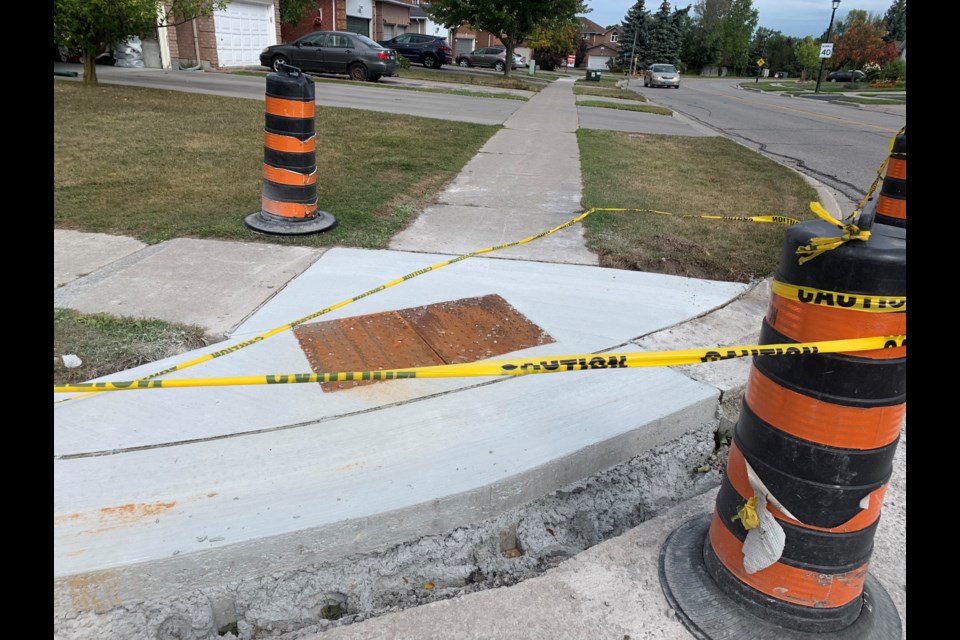A Newmarket resident curious about what appears to be rusted metal plates installed at sidewalk intersections in her neighbourhood sparked a lively discussion on social media last weekend.
After posting a photo to a Newmarket Facebook group that showed two metal plates affixed to a sidewalk in her neighbourhood, Suzan Cordes-Challis wrote: "I’m hoping someone can explain what these are that are being installed on sidewalk corners. ...I hope there is some amazing use for them because they are as ugly as all get out!” At least the rusted look matches the Newmarket sign on Main!”
Those rusty-looking metal slabs are known as tactile plates and allow people with visual impairments to “feel” or “sense” the intersection underfoot or with a cane and know where to cross, according to a Town of Newmarket spokesperson.
The tactile plates or tactile walking surface indicators, as they are also known, are made of durable cast iron touted for its low-maintenance, non-skid properties and ability to adhere to concrete.
They are meant to alert people with visual impairments to potential hazards such as traffic by providing a warning underfoot. The temporary rust colour that often stains the sidewalk in the first year eventually fades into a patina that also has a job to do by providing a contrast between it and the sidewalk.
The Town of Newmarket, along with 400-plus municipalities in Ontario, has been installing tactile plates at intersections when new sidewalks are built or replaced. It is a move to be in compliance with accessibility standards for public spaces that came into effect in 2016 under the Accessibility for Ontarians with Disabilities Act, 2005.
But as a 2019 legislative review of the act found with regard to the design of public spaces standards, “the regulations are creating new barriers for some people while trying to make improvements for others”.
“Tactile plates required at curb cuts for pedestrian crossings to assist people who are blind were said to pose a barrier for those with mobility devices,” Ontario’s former Lt.-Gov. David Onley wrote in his report to the provincial government. “Power doors with buttons that have to be hit work for some people but not for all. In playgrounds, wood chips are considered an accessible surface but in fact they keep wheelchairs from getting through.”
For Newmarket’s Terry Dranitsaris, who lives at Eagle and Sandford streets and uses a wheelchair to go about her day-to-day business in town, the tactile plates are nothing short of a menace.
Already, Dranitsaris has faced upward of $3,000 in repairs to the castor wheels on her wheelchair, which act as her front-wheel drive, because they get “shredded” with each pass over the studs on the plates.
“I try to go around them but it’s impossible; the castor wheels and the main tires go over them and I know eventually it’s just going to ruin the tires,” Dranitsaris said. “It’s very expensive to repair and it’s happened once. This could potentially be a problem for me all the time since these plates are here to stay permanently.”
“If I want to go to the Upper Canada Mall, I go to Yonge Street and I have to go over these grids and there’s no way of getting around them,” she said, adding that with all the new sidewalks being built in Newmarket, the tactile plates seem to be everywhere.
“I look at these grids and say to myself, ‘If I go ever so slowly over them, maybe they won’t damage my brand-new wheelchair’,” she said. “They have to come up with a better solution for the safety of everyone.”
Dranitsaris takes issue with the assertion that the tactile plates are not slippery in the winter, as she skidded in her wheelchair last winter while out doing errands.
“Whoever said these plates are not slippery in the wintertime, that’s foolish,” she said. “If I let go of the joystick, the wheelchair will continue to go if it's icy. I know, I’ve been around the block a lot of years. Because if there’s ice on any surface, it doesn’t matter what kind of tire or tread on your shoe, you’re going to fall or slip. Ice is ice.”
Getting around in Newmarket has become increasingly difficult for those who use a mobility device, including electric scooter, said Dranitsaris. She counted among the more challenging aspects trying to navigate construction zones such as Yonge and Davis.
“Even stores that are supposedly wheelchair-accessible put product displays at the end of the aisles, which makes it difficult to get around those products because they’re blocking part of the aisle way,” Dranitsaris said. “It’s pathetic. Trying to get into some stores is unbelievable, it’s totally impossible to get into some of them.”
Main Street is a case in point, she said, where even a small ramp or lip over the doorway of local businesses would assist her to get in. Dranitsaris has since stopped going to her favourite restaurant on Main because it hasn’t yet taken the steps to make it accessible.
The Accessibility for Ontarians with Disabilities Act sets out rules, regulations and standards to improve accessibility for all in the province by 2025.
In addition to tactile plates, municipalities are installing accessible pedestrian signals that feature raised tactile arrow points in the direction of the pedestrian crossing with an arrow that vibrates when activated. A 'cuckoo' locator sound is heard for north-south, and a 'chirp' for east-west.
For more information, visit here.